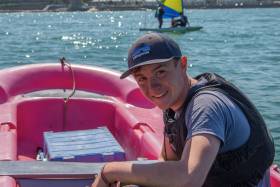Displaying items by tag: Junior Club
What’s In Store For The INSS Junior Club This Term?
#INSS - Over on the Irish National Sailing & Powerboat School website, Jeff Fahy gives the lowdown for what the 15-17 age group can expect as the INSS Junior Club resumes this weekend.
Dinghy and keelboat sailing will be the focus, with sailing out of the harbour as much as possible on RS Quests, Topaz Vibes and Laser Picos before more wintery weather prompts the move to 1720 Sportboats — on which youths will learn how to sail with asymmetric spinnakers.
Fahy reminds all students to bring their logbooks and keep them up to date, so that INSS instructors can determine what one needs to work on. The INSS website has more HERE.
INSS Junior Club Is Back For Autumn Term This Saturday
#INSS - Saturday sailing with the Irish National Sailing & Powerboat School’s Junior Club is back this coming Saturday 8 September.
Students from the summer courses and new sailors alike are invited to continue sailing throughout the school term.
The Junior Club is an excellent way to practice and improve upon the skills learnt during the summer months and it’s also a great way to keep in touch with the friends made during the summer courses.
The autumn term runs each Saturday from 8 September to 1 December. Sailing then resumes on 2 February and continues every Saturday (except 20 April) till 4 May.
Sailors can choose from two times to attend, either 10am to 1pm or 2pm to 5pm.
As with the summer courses, sailors are divided by age and then by experience, this ensures that they continue to be challenged and improve their sailing ability.
In the 7-10 age group, Optimist sailing will be a central part of the planned activities, as the sailors begin to progress we will start to introduce them to the Toppers, a larger and faster boat. Trips to feed the local family of seals as well as plenty of fun and games are also planned.
For those aged 11 to 14, the term is designed to keep participants’ skill levels up while introducing them to new boats like the Laser Pico or the RS Feva. Trips aboard the club’s 1720 Sportboat fleet are a key part of the calendar.
Sailors aged 15 and over will be introduced to the Topaz Magnos, Vibes and Laser Vago for spinnaker and trapeze training. The group will also spend time sailing squib keelboats and 1720 Sportboats.
In addition, the Junior Club is an excellent way to complete the Physical Recreation or Physical Skill sections of the Gaisce President’s Award.
The cost per term is €335, which includes the use of all INSS equipment and wetsuits, plus complimentary hot chocolate on the colder days. Book both terms at the same time for the reduced price of €619.
Taster sessions are also available for students that want to try out the club, at just €30.
New members are welcome to join the Junior Club at any time throughout the year; fees are calculated at a pro rata basis.
Bookings can be made online at the INSS website or over the phone at 01 284 4195.































































